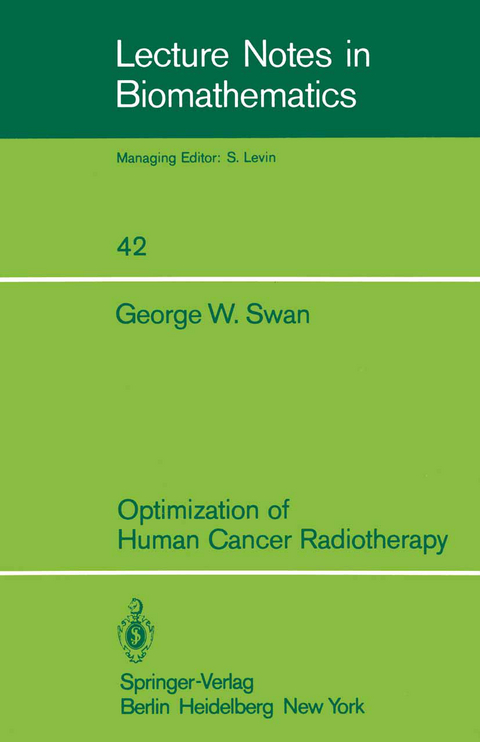Optimization of Human Cancer Radiotherapy
Springer Berlin (Verlag)
978-3-540-10865-8 (ISBN)
1 General Introduction.- 1.1 Introduction.- 1.2 History of Cancer and its Treatment by Radiotherapy.- 1.3 Some Mathematical Models of Tumor Growth.- 1.4 Spatial Distribution of the Radiation Dose.- 2 Survival Curves from Statistical Models.- 2.1 Introduction.- 2.2 The Target Model.- 2.3 Single-hit-to-kill Model.- 2.4 Multitarget, Single-hit Survival.- 2.5 Multitarget, Multihit Survival.- 2.6 Single-target, Multihit Survival.- 2.7 Properties of In Vitro Survival Curves.- 3 A Molecular Model of cell Survival.- 3.1 Introduction.- 3.2 The Molecular Model.- 3.3 Interpretations of the Molecular Model.- 4 Kinetic Models of Biological Radiation Response.- 4.1 Introduction.- 4.2 Basic Postulates in the Dienes Model.- 4.3 Low LET Kinetic Models with no Recovery.- 4.4 Further Discussion of the Models.- 4.5 Low LET Kinetic Models with Recovery.- 4.6 Low LET and High LET Kinetic Model with No Recovery.- 4.7 Other Kinetic Schemes: Sparsely-ionizing Radiation.- 4.8 Kinetic Schemes with Age-specific Compartments in the Cell Cycle.- 4.9 Thermal Potentiation of Cell Killing.- 5 Cell Survival after Successive Radiation Fractions.- 5.1 Introduction.- 5.2 Some Results in Connection with Instantaneous Cell Kill and Exponential Tumor Growth.- 5.3 Instantaneous Cell Kill Followed by Logistic Growth of Normal Tissue.- 5.4 Cohen's Cell Population Kinetics Programs.- 5.5 A Model of Radiation Therapy with Resistant and Sensitive Cell Populations.- 5.6 Dose Fractionation and General Survival Curves.- 6 Optimization Models in Solid Tumor Radiotherapy.- 6.1 Introduction.- 6.2 Optimal Radiotherapy of Tumor Cells Based on Cumulative Radiation Effect and a Multitarget, Single-hit Survival Function.- 6.3 Optimal Radiotherapy of Tumor Cells Based on Cumulative Radiation Effect and anExponential-quadratic Survival Expression.- 6.4 Fractionation Scheme with a Four Level Population Tumor Model.- 6.5 A Dynamic Programming Solution to the Problem of the Determination of Optimal Treatment Schedules.- 6.6 Optimal Treatment Schedules in Fractionated Radiation Therapy for Fischer's Tumor Model.- 6.7 Optimal Radiation Schedules with Cell Cycle Analysis.- 7 Numerical Solution of Multistage Optimal Control Problems.- 7.1 Introduction.- 7.2 Continuous Time Optimal Control.- 7.3 Optimization of Multistage Systems.- 7.4 Multi-dimensional Optimization by Gradient Methods.- 7.5 Gradient Method with Penalty Function.- 7.6 A Numerical Scheme for a Nonlinear Problem.- 7.7 The Method of Conjugate Gradients.- 7.8 Discrete Dynamic Programming.- 8 Some Optimization Criteria in Radiotherapy.- 8.1 Introduction.- 8.2 Therapeutic Policy, Strategy and Tactics.- 8.3 Optimization and Clinical Trials.- 8.4 Score Functions and Age Response Functions.- 8.5 Comparison of Models Used in Optimization Procedures.- 8.6 The Complication Probability Factor.- 9 The Optimization of External Beam Radiation Therapy.- 9.1 Introduction.- 9.2 Some Approaches for Treatment Plans.- 9.3 Linear Programming.- 9.4 Linear Programming and Radiation Treatment Planning.- 9.5 Optimization of External Beam Radiation Therapy Using Nonlinear Programming.- 9.6 Quantitative Study of Relative Radiation Effects and Isoeffect Patterns.- 10 Reconstructive Tomography.- 10.1 Introduction.- 10.2 Reconstruction Algorithm.- 10.3 Numerical Approximations for the Attenuation Coefficient.- 10.4 Cross-sectional Absorption Density Reconstruction for Treatment Planning.- 10.5 Towards the Optimization of Dose Reduction in Computerized Tomography.- 10.6 Other Imaging Technologies.- Appendix 1.- Appendix 2.- Appendix 3.
| Erscheint lt. Verlag | 1.10.1981 |
|---|---|
| Reihe/Serie | Lecture Notes in Biomathematics |
| Zusatzinfo | VIII, 284 p. |
| Verlagsort | Berlin |
| Sprache | englisch |
| Maße | 170 x 244 mm |
| Gewicht | 480 g |
| Themenwelt | Informatik ► Weitere Themen ► Bioinformatik |
| Mathematik / Informatik ► Mathematik ► Algebra | |
| Mathematik / Informatik ► Mathematik ► Angewandte Mathematik | |
| Medizin / Pharmazie ► Medizinische Fachgebiete ► Onkologie | |
| Schlagworte | Biologisch-mathematisches Modell • Cancer • Imaging • Krebs • Optimization • radiotherapy • Strahlentherapie • Strahlentherapie / Radiotherapie • tumor growth |
| ISBN-10 | 3-540-10865-3 / 3540108653 |
| ISBN-13 | 978-3-540-10865-8 / 9783540108658 |
| Zustand | Neuware |
| Informationen gemäß Produktsicherheitsverordnung (GPSR) | |
| Haben Sie eine Frage zum Produkt? |
aus dem Bereich




